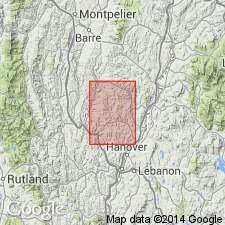
- Usage in publication:
-
- Meetinghouse slate member
- Modifications:
-
- Original reference
- Dominant lithology:
-
- Slate
- AAPG geologic province:
-
- New England province
Summary:
Pg. 19. Meetinghouse slate member of Gile Mountain schists.
Described as gray and black micaceous slates often showing brownish
stains. Very thin quartzite layers often interbedded. Excellent cleavage.
Estimated thickness about 1,100 feet. Upper member of Gile Mountain
schists. Age is considered Devonian.
Named from Meetinghouse Hill [now Westinghouse Hill], in southeastern part of Strafford 15-min quadrangle (1896 ed., reprinted 1937), Orange Co., VT.
Source: US geologic names lexicon (USGS Bull. 1200, p. 2450-2451).
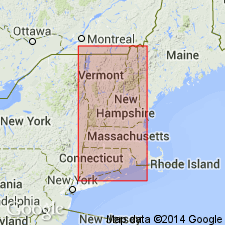
- Usage in publication:
-
- Meetinghouse Slate*
- Modifications:
-
- Revised
- AAPG geologic province:
-
- New England province
Summary:
A unit of dark-gray, carbonaceous phyllite interbedded with minor thin (up to 15 cm) beds of punky-brown-weathering granulite and local thin, graded quartzite beds, which forms a narrow (0.5 to 1 km) unit along the west margin of the Connecticut Valley trough in east-central and northeastern Vermont, mapped as the Northfield Formation, has long been considered the basal unit of a synclinorium, underlying the Waits River Formation and equivalent to the Meetinghouse Slate on the east margin of the trough. It is here reinterpreted as a distal facies of the Gile Mountain Formation, which is at the top of the Connecticut Valley trough sequence, here interpreted as a fault-bounded anticlinorium. The Meetinghouse Slate (Member of the Gile Mountain Formation of Doll and others (1961)) is also here interpreted as lying at the top of the sequence. Age is Early Devonian.
Source: GNU records (USGS DDS-6; Reston GNULEX).
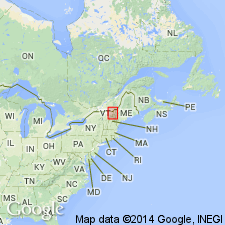
- Usage in publication:
-
- Meetinghouse Slate Member*
- Modifications:
-
- Biostratigraphic dating
- AAPG geologic province:
-
- New England province
Summary:
Presence of plant fossils in northern NH and southern Quebec supports a late Early Devonian (Emsian) age for the Gile Mountain Formation and its equivalent, the Compton Formation. Gile Mountain includes the Meetinghouse Slate Member and the newly assigned Northfield Member, here considered a distal western facies of the Gile Mountain equivalent to the Meetinghouse. Authors conclude that the rocks of the Connecticut Valley trough accumulated continuously beginning as early as the Silurian and extending into the latest Early Devonian.
Source: GNU records (USGS DDS-6; Reston GNULEX).
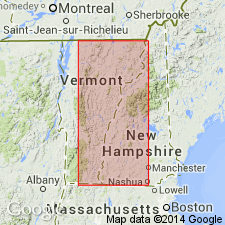
- Usage in publication:
-
- Meetinghouse Slate Member*
- Modifications:
-
- Revised
- AAPG geologic province:
-
- New England province
Summary:
Structural studies in northeastern and east-central VT show that the belt long known as the Connecticut Valley synclinorium is a faulted anticline, and it is here renamed the Connecticut Valley trough. The Waits River Formation underlies the Gile Mountain Formation. The Northfield Formation and Meetinghouse Slate Member of the Gile Mountain Formation were interpreted as resting depositionally on older rocks to the west and east. The Northfield is revised as the Northfield Member of the Gile Mountain Formation, at the top of the Gile Mountain, rather than a separate formation below the Gile Mountain-Waits River package. The Meetinghouse Slate (Member of the Gile Mountain Formation of Doll and others (1961)) is revised as the Meetinghouse Slate Member of the Gile Mountain Formation, but at the top rather than at the bottom of the formation. The Standing Pond Volcanics (Standing Pond Volcanic Member of the Waits River Formation of Doll and others (1961)) is retained as the Standing Pond Volcanic Member of the Waits River. The age of all trough rocks is here modified to Early Devonian.
Source: GNU records (USGS DDS-6; Reston GNULEX).

- Usage in publication:
-
- Meetinghouse Slate Member*
- Modifications:
-
- Age modified
- Overview
- AAPG geologic province:
-
- New England province
Summary:
Gile Mountain Formation and its Meetinghouse Slate Member were previously considered to be Early Devonian based on Emsian plant fossils from Compton Formation of QUE (Hueber and others, 1990; Hatch, 1991). Age assignment here changed to Early Devonian(?) because recent mapping indicates that Gile Mountain and Compton are not coextensive across VT-QUE border as formerly believed by Doll and others (1961, State map) and St. Julien and Slivitsky (1987). Instead, the formations are separated by Ironbound Mountain Formation. Ironbound Mountain Formation is conformably overlain by Compton, but it is not yet known whether Ironbound Mountain is overlain or underlain by Gile Mountain; this is shown by queried Ironbound Mountain-Gile Mountain contact in area of Averill 7.5-min quad, VT. Correlation of Gile Mountain and Compton is justified only if Gile Mountain in this area conclusively is shown to be underlain by Ironbound Mountain; otherwise, Gile Mountain (with possible exception of its Meetinghouse Slate Member) would be coeval with Silurian Frontenac Formation. Hatch (1988) proposed that Meetinghouse represents upper part of Gile Mountain on basis of graded bedding seen south of map area. This relationship is not proven, however, because Gile Mountain-Meetinghouse contact is difficult to define and graded beds are not always easily interpreted. On this map, Meetinghouse is tentatively shown to occur below main body of Gile Mountain on basis of remarkable similarity between it and Ironbound Mountain Formation. This relationship easily explains highly pelitic character of the Meetinghouse with upward-coarsening character of Lower Devonian sequences elsewhere in map area. Meetinghouse Slate Member includes volcanic facies.
Source: GNU records (USGS DDS-6; Reston GNULEX).
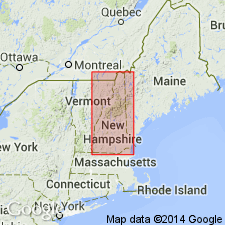
- Usage in publication:
-
- Meetinghouse Slate Member*
- Modifications:
-
- Overview
- AAPG geologic province:
-
- New England province
Summary:
Used as Meetinghouse Slate Member of Gile Mountain Formation of Early Devonian age. Consists of gray to black phyllite and silty metasandstone turbidite. Report includes geologic map, cross sections, correlation chart, and four 1:500,000-scale derivative maps.
Source: GNU records (USGS DDS-6; Reston GNULEX).
For more information, please contact Nancy Stamm, Geologic Names Committee Secretary.
Asterisk (*) indicates published by U.S. Geological Survey authors.
"No current usage" (†) implies that a name has been abandoned or has fallen into disuse. Former usage and, if known, replacement name given in parentheses ( ).
Slash (/) indicates name conflicts with nomenclatural guidelines (CSN, 1933; ACSN, 1961, 1970; NACSN, 1983, 2005, 2021). May be explained within brackets ([ ]).

